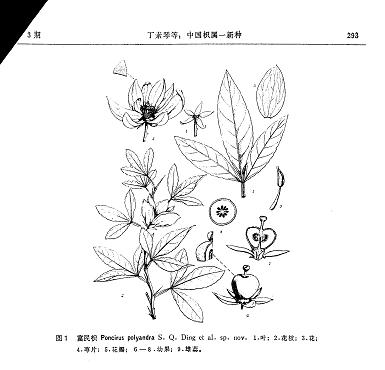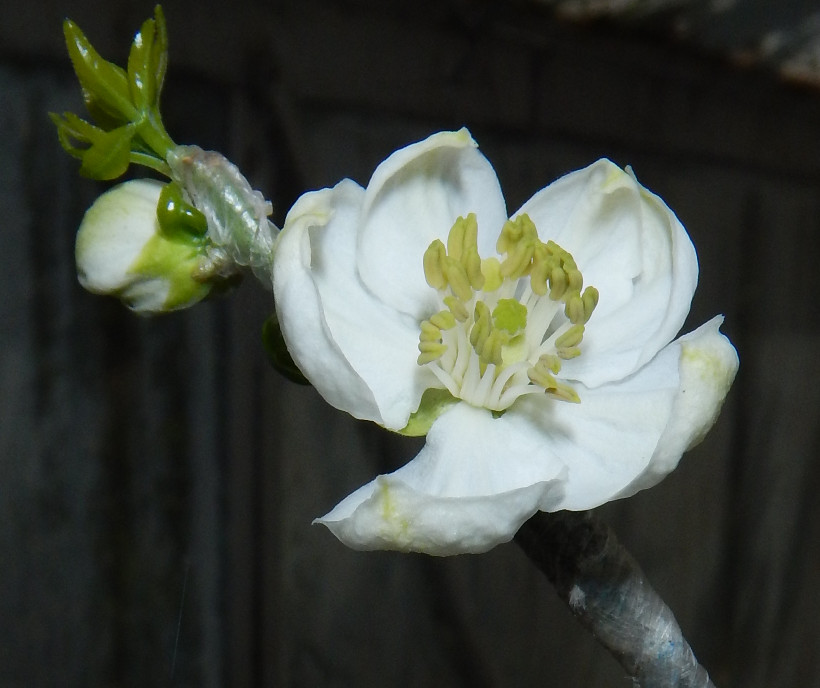Son surnom c'est FETO, Fuming Evergreen Trifoliate Orange (Poncirus Polyandra).
On le trouve dans le conté de Fuming de la province du Yunnan à une altitude de 2400m.
Le feuillage est persistant. Les fleurs on de 5 à 15 pétals. Elles sont simples ou doubles. Seuls 5% sont fertiles.
Les fruits sont nettement plus gros que ceux du PT, 64 à 130g.
Information about FETO Fuming Evergreen Trifoliate Orange (Poncirus Polyandra)
PRIMARY STUDY OF FUMING EVERGREEN TRIFOLIATE ORANGE (P. trifoliata Raf.)*
DUAN Zhiyu
Fuming Station of Tea, Mulberry & Fruit, Yunnan, P. R. China
Abstract We have studied Fuming evergreen trifoliate orange for more than 10 years. Detailed morphological and botanical characters are described. It is a primitive species of Poncirus, which is more dwarf than the ordinary trifoliate orange, and requiring further study.
Trifofoliate orange is the most useful rootstock in citrus production. It is a deciduous with trifoliate compound leaf; the ovary is covered with short pubescence with bitter oil in juice.
We have discovered Fuming evergreen trifoliate orange in 1978 in Yunnan Province.
From 1978 we have investigated its native home several times and have transplanted some plants in our orchard for detailed observation. Nearly 26 citrus cultivars had been grafted on it using common trifoliate orange as check. The experiment results are enumerated as follows.
1. BASIC CONDITION
Fuming evergreen trifoliate orange is known as a wild citrus or wild trifoliate orange. It distributes on the mountain in Fuming County of Yunnan Province, about 10 mow's area on the altitude of 2,400 m with annual rainfall of 1,130 mm, annual mean temperature of 1 10C. The soil is heavy sand loam with small gravel's. Its companion plants arc Arundinella anomala Steud, Filicales, Mashonia japonica DC etc. Wild Fuming evergreen trifoliate orange trees are gradually decreasing. Many plants of Fuming evergreen trifoliate orange have been preserved in our experimental orchard.
II. MAIN DIFFERENCE BETWEEN FUNING EVERGREEN TRIFOLIATE ORANGE AND ORDINARY TRIFOLIATE ORANGE
Key to the species of Poncirus:
1. Palmate trifoliate compound leaf with narrow wing-like petiole. Flower buds are formed on the branches of last year in the axilaris, ovary with short pubescence, juice with better oil
2. Evergreen with 2-3 times flowering in a( year, 5-15 petals, 32-37 stamens, ovary spheroid with retusus on the fruit tip, 7-10 segments, rind pale yellow colour --------------> Fuming evergreen trifoliate orange
22. Deciduous, flowering only once a year, with 5 petals, 8-20 stamens, ovary subglobose, fruit globose with 6-8 segments, rind orange colour -----------------> Ordinary trifoliate orange (Poncirus trifoliata Raf.)
III. BOTANICAL CHARACTERS
Fuming evergreen trifoliate orange is a bushy evergreen tree, with many branches without center trunk but with many branches. The canopy of the tree is cylindrical, erect, the angle between the branches is acute, 40~50°.
The main branches are grey brown with white lineate. A 13-year-old tree is about 3.6 m tall with 40 cm trunk circumference. Diameter of the tree canopy is 1.6 x 1.5 m. The current shoots are 2-22 cm. Most of them are 10 cm long, while young shoots are always triangular with pale green colour. When ripen the angle disappear turn to round shape with dark green covered with white lines. Most current shoots are round curve dependence. Internodes are 0.5-3.5 cm; each node has a leaf. In the leaf axils have a bud and a thorn. The thorn is conical; 0.5-3.7cm, most are 1.5 cm.

Fig. 1. Fuming evergreen trifoliate orange (1. flower shoot; 2. pistil stamens; 3. Fruiting shoot; 4. Seed).
Leaf is palmate trifoliate, leathery, the middle rib is prominent, upper of the leaf is dark green, leaf back is yellow green. The leaf stalk has narrow wings of 0.5-3.5cm long; most are 1.5 cm. The tip leaflet is 3-3.6 cm long, 0.7-2 cm broad. Lateral leaflets are smaller than tip leaflet, always 2 / 3 long as the tip leaflet.
The flower is in the leaf axil, with single and rarely double flowers. The flower~~i~e2 papery, flower size is not even. The flower diameters are 2-5.5 cm with extreme ~ 0.3 cm. The flower bud is napiformis rather large and prominent with 5 lobed sepals, Yellow green ovoid shape. Petals are 5-15, oblong or obverse ovate, 2-2.5 cm long, 1.4-1.8 cm broad with white, short pubescence. The flower has two kinds single layer and double flower. Stamens are 32-37 rather even; the filaments are separate from the base 0.7-0.8 cm long. Anther yellow, pollen sac conical 0.3 cm tip point. Pistil's style upright 0.3 cm long, diameter 0.15 cm, stigma green yellow, little retusus, 0.3 cm diameter long and 0.25 diameter wide, little higher than the stamens.
The ovary is spheroidal; tip depressed dark green with white short pubescence, diameter 0.5 cm. Most flowers are female sterile, the stigma and the ovary are withered. The perfect flowers with developed pistil are very few, about 5% of whole flowers. Fruit is spheroidal, pale yellow, 4.4-4.5 diameter long and 5.3-7.5 cm wide. Fruit weight 64-130 g, averaging 97 g. The fruit surface is rough with ridges and white short pubescence, oil glands small and intensive, evenly distributed. The fruit tip is depressed, about 0.5-1.2 cm deep, with 5-6 unequal irradiated ridges, 2-3 cm long and 2-3 high, the style scar is not clear. The carpopodium 0.3-0.5 cm, diameter 0.5 cm. From the carpopodium there are 9-12 irradiated vallicules 1.5-3.5cm long, and 0.10.5cm deep, narrower than its top.
The rind is 0.3-0.5 cm thick, rather crisp, quite loose and easy to peel. The spongy tissue is white, loose, about 1 / 3 - 1 / 2 of the thickness of rind. Oil glands yellow, round shape, diameter 0.1 cm, 1-2 layers, the outer layer are arranged evenly, the inner layer arranged unevenly and looser, the membrane of the segn3ient is very thin, easy to break, juice quite much, contains bitter oil, unsuitable to eat. The core is solid, diameter 1-1.4 cm.
The seeds of the fruit are 30-36, per hundred fresh seeds weight 60 g. The seed is nearly ovate 1.2 cm long and 0.9 cm wide, no beak; the external seed coat is pale yellow brown, leathery tough; the inner seed coat is thin with yellow brown, the chalaza is purple brown. The cotyledon is milky white; embryo is ellipsoid, yellow green, polyembryonic percentage germination is over 95%.
Fuming evergreen trifoliate orange tree root system is shallow, without developed main root but with well-developed lateral roots, and with strong suckering ability.
Shoot-growth is 3 times a year. Fuming evergreen trifoliate orange' s spring shoots start growth in early March, summer shoots in early June and autumn shoots in late August. It flowers 2-3 times in one year, usually 3 times respectively in early March, mid May and early August. Fruit can be set in each time, but best in March. The first flowering fruit is ripened in early October. The second flowering fruit ripened at the end of October.
IV. GRAFTING AND CULTIVATION
For more than 10 years we have used the F.E.T.O. as rootstock for 26 orange cultivars and have planted them in our experimental orchard. The results are as follows:
1) F.E.T.O. can be used as rootstock for sweet orange, satsuma mandarin, ponkan, citron, kumquat and pumelo etc. with 26 cultivars. Its compatibility is much like the ordinary trifoliate orange.
2) It is rather precocious and early bearing with wide adaptability. The colour and quality of the fruits are almost like the ordinary trifoliate orange, but when grafted with Hamlin sweet orange, Ponkan and Wase satsuma mandarin, their fruits ripen 5-10 days earlier than on the ordinary trifoliate orange rootstocks.
3) The F.E.T.O. rootstock has the anti- brown ants character, better than trifoliate orange.
4) The F.E.T.O. used as citrus rootstock, the growth under the graft union is much larger than the trifoliate orange rootstock and the dwarfing effect is more prominent, so it can be used for density planting.
5) The F.E.T.O. is unsuitable as rootstock for few cultivars: Dai Dai and Nanfeng mandarin.
Table 1. Comparison of the dwarfing effect of F.E.T.O. and ordinary trifoliate orange
Cultivar Age of tree Sp. of stock Height of tree Canopy diam. (mxm)
Unshiu 7 F.E.T.O. 1.2 1.8x1.9
Unshiu 1 7 Trifoliate orange 2.1 2.0x2.1
Hamlin 7 F.E.T.O. 1.2 1.5>< 1.6
Hamlin 7 Trifoliate orange 2.6 2.2x2.2
Mandarin 8 F.E.T.O. 1.7 1.0>< 1.0
Mandarin 8 Trifoliate orange 2.2 1.3>< 1.4
V. SUMMARY
The F.E.T.O. is an evergreen trifoliate orange discovered in Fuming County of Yunnan Province, China.
The morphological characters are also different as: the leaves are larger, the petals number arc more, 5-15, the stamens are also more than the ordinary trifoliate orange, 8-20, it has
32-37 stamens and the fruit is 64-130 g, larger than ordinary trifoliate fruit, which is only 18-25g, with an average of 36 seeds while the trifoliate orange has only 25.
It is supposed that Fuming evergreen trifoliate orange is a primitive species of the trifoliate orange family.
According to our grafting and cultivation experiment study, we suggest that F.E.T.Q. may be used as a dwarfing rootstock for many citrus cultivars.
REFERENCES
1. Yu DJ. Chinese Systematic Pomology. Chinese Agr. Sci. Publ. Co., 1979.
2. Chen HY, Sun NJ. "Guanyun" No. 1 - The tetraploid trifoliate orange discovered in Guanyun County. Acta Hort. Sin. Vol. 16, No. 1, 1989.
3. Central China Agr. Univ. Research Methods in Fruit Growing. Chinese Agr. Sci. Publ. Co., 1979.
http://www.zitrusgarten.net/homepage/feto.htm



 http://www.plantphoto.cn/tu/362903
http://www.plantphoto.cn/tu/362903
 http://english.kib.cas.cn/rh/rp/201301/ ... 98591.html
http://english.kib.cas.cn/rh/rp/201301/ ... 98591.html






